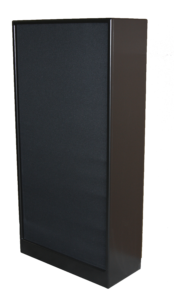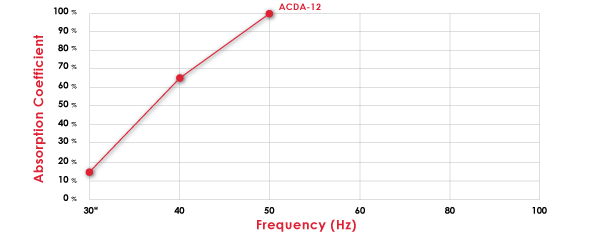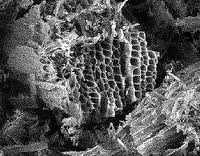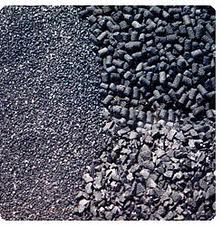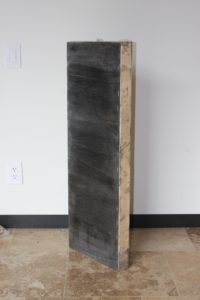Our low frequency charcoal bass absorbers absorb at rates and levels never before achieved in freestanding units which means the bass issues in your room can once and for all addressed. This technology took 18 years to develop and can now be installed in a new construction or remodel situation. You can turn your whole studio wall into a bass absorber or have numerous freestanding units deployed around your room.
ACDA-12 New Design
Why Do You Need This? Because Your Room Is Getting In The Way Of Sonic Perfection!
Our low frequency absorption rates have been independently tested and verified by the World famous Riverbank Acoustical Laboratories. You can see their report here: ACDA 12 Riverbank Acoustical Labs Testing Results and the graph below shows the absorption levels verified in the report… Yes it’s true, the ACDA 12 absorbs 100% at 50 Hz. and does a great job all the way down to 30 Hz.!
ACDA-12 Absorption Performance Chart
- You will be amazed as to how your musical presentation in your room opens up and allows all instruments and vocals to be heard with clarity and definition.
- This openness or “air” will bring new interest and attention to your musical presentations because you will simply be able to hear more of the music that you enjoy so much.
- There is a lot of information below 80 Hz. that most rooms will not let you hear which means that with our ACDA units you will hear separate notes that have their own attack and decay without being covered in resonance producing mud.
- All of this information has always been in your room, you just were not able to hear it. Now, with our activated carbon diaphragmatic absorbers, you will hear more than you have ever heard before or even thought possible!
Low Frequency Absorption Requires Mass
If you are going to have an absorber that really does work around 30 Hz. you need a good strong cabinet to try and slow down some of the energy. You also need a front wall system that has two walls, so you can slow down twice as much energy before it enters the inside of the absorber.
Charcoal Or Activated Carbon Powerful Absorber
Inside the unit, the sound energy meets 65 pounds of activated carbon or charcoal. Why charcoal? Because each small piece of charcoal or activated carbon looks like a miniature meteor. It is full of holes, just like a meteor and so has a huge amount of surface area per gram of material, 2,000 square meters per gram in fact! These holes are for sound absorption. Sound enters the pore and bounces around converting to heat and thus reducing its energy signature.
Activated Carbon Showing Pores
High Degree Of Porosity
Your sound energy enters those millions and millions of holes within the 65 pounds of carbon and is absorbed at a high rate and low level. With the inert, thick cabinet walls and dual wall face, we now add the 65 pounds of carbon or charcoal. The end result is a real, hard working, diaphragmatic low frequency sponge, that can and does go down into the 30 cycle region. Don’t take our word for it. Look at the Riverbank Labs independent test results. Charcoal bass absorbers are the way to go.
Rigid, Multiple Layered Cabinet
Our final production units, the ACDA-10 diaphragmatic absorber which you can see here, and ACDA-12 diaphragmatic absorber which you can see here, took 8 years to develop. Numerous cabinet construction techniques were used before we finally centered on numerous layers of materials with damping compound sandwiched between each layer. We tested mineral wool, fiberglass, foam, both open and closed cell, even a filtering agent called Zeolite. We settled on carbon or charcoal for our internal cabinet fill. Activated carbon gave us the most absorption for amount of space required.
Place In Areas Of High Pressure
Put them next to any area in your room where sounds are exaggerated. No more exaggeration or boom. All you will hear now is everything you could not hear before because of the boom. Place them behind your speakers to soak up all that extra speaker / back wall boundary interference. Always have some in the corners of your room and behind your speakers or better yet, build the activated carbon technology directly into your new personal listening, home theater, or professional recording studio.
Two Types: Broadband And Frequency Specific
There are two low frequency absorbers. The ACDA-10 is a broadband absorber that goes from 35 Hz. – 400 Hz. If you want to extend its performance add one of our three foam thicknesses to the face. The ACDA-12 is the most powerful unit we have ever made. It starts at 35 Hz. just like the ACDA-10 but that is where the similarity ends. We have 63% absorption at 40 cycles and 100% at 50 cycles according to Riverbank Labs independent testing. These are powerful, low frequency sponges that really absorb a large amount of energy in a small amount of space.
Go check them out now:
ACDA-10 ACTIVATED CARBON DIAPHRAGMATIC ABSORBER
ACDA-12 ACTIVATED CARBON DIAPHRAGMATIC ABSORBER
LISTEN TO THE MUSIC WITHOUT HEARING THE ROOM

